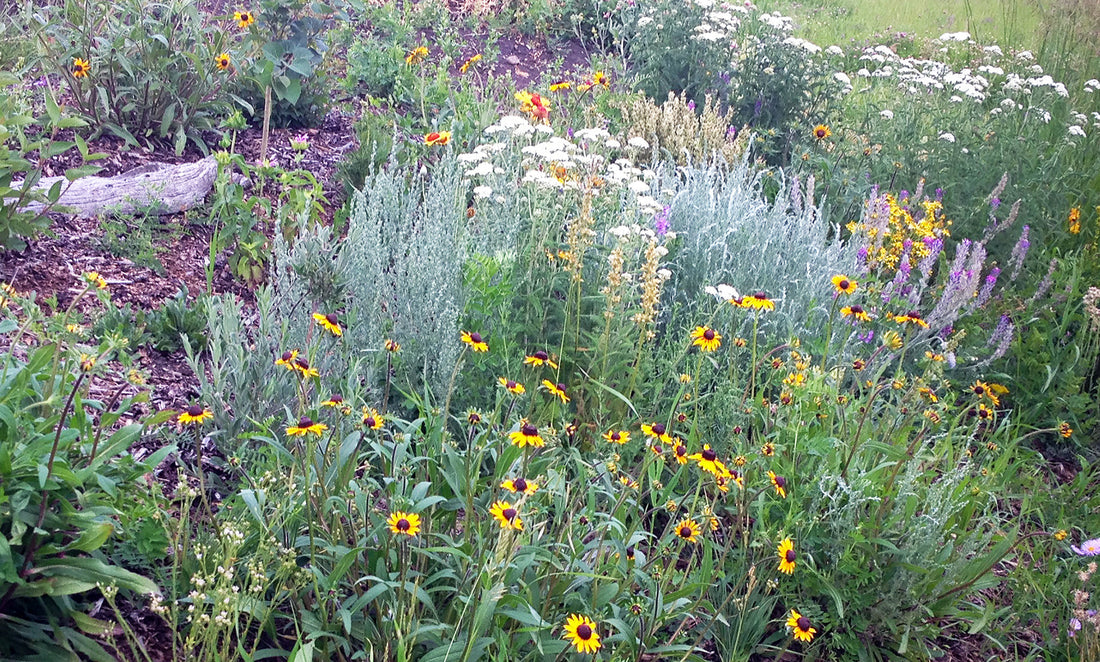
🌿 What to Expect When Seeding Native Perennial Wildflower Mixes
Share
So, you're thinking about incorporating wildflowers into your yard? That’s awesome—there are so many native plants that are both beautiful and well-adapted to our environment. Many need little or no assistance once planted in the right conditions, but it’s important to do your homework.
Maybe you’ve decided that seeds are the way to go. Perhaps you’ve seen wildflower seed bags at the grocery or hardware store and are imagining a simple process: open the bag, scatter the seed, water it for a few days, and wait for the blooms. You might expect flowers this year.
[Cue record scratch.]
What you’ve just envisioned is an annual flower mix, not a native perennial wildflower mix. And while both may be labeled "wildflowers," they’re very different things.
Common Misconceptions About Native Wildflower Seed Mixes
1. “I should expect a full bag of seed.”
Those small sacks of wildflower mixes at the store? Over 98% of the volume is usually filler, such as vermiculite. Filler helps distribute the seed more evenly and can hold moisture to aid germination. But it also disguises how little seed is actually in the mix—volume ≠ quantity.
🔗 Click here to learn more about seed volume.
2. “I’ll see flowers this year.”
You might see a few blooms in the first year, particularly from biennials or short-lived perennials included in the mix. But most native perennials won’t flower in year one. Some species, like Wood Lilies, can take 5–7 years to bloom.
🔗 Need help understanding annuals, biennials, and perennials? Click here.
3. “The seeds will germinate all at once, like grass.”
Native wildflowers vary widely in their germination habits. Some need cold periods (even multiple winters), others germinate in early spring or warm soil, and some stagger their emergence over years. Expect germination in stages—not a synchronized flush.
🔗 Click here to learn why we don’t recommend mixing grasses with wildflowers.
4. “Native plants grow like weeds—they won’t need any help.”
While some native plants are aggressive, most take years to establish. When you see a natural field of wildflowers—remember, that took time.
If your land already has native species, protect them. Once lost, ecosystems are hard to restore—and your contractor won’t be back to fix it two years from now.
5. “Seeds are cheaper than plants.”
Not always. Especially when you're buying authentic, hand-collected native seed—sometimes gathered in the wild where bears live!
Some commercial crops like Blue Flax are machine-harvested and less costly. But many species require careful, seasonal wild collection with no guarantee of success.
👉 Hand-collected, source-identified seed is in a different universe than commercial seed crops.
Behind the Scenes: What Goes Into Our Seed Mixes
- We do the plant selection homework to support bloom timing and habitat needs.
- Mixes may be adjusted annually based on seed availability.
- Each envelope is hand-packed so you get every species listed.
This isn’t a pre-mixed scoop from a bin—it’s custom-built.
Why Seed Isn’t Always “Cheaper” in the Long Run
Native seed mixes take time to establish. Expect at least one full growing season before blooms, and full establishment may take years.
We recommend:
- Creating wildflower islands in large spaces instead of seeding everything.
- Combine perennial seed mixes with plugs, annuals, grasses, or existing perennials.
- Seeding around existing plantings like shrubs and trees where soil contact is good.
🔗 Read more about creating wildflower islands.
Why It’s Still Worth It
- Longevity: Perennials can live for decades once established.
- Seasonal diversity: Mixed species bloom from spring through fall.
- Resilience: Adapted to local conditions and weather patterns.
- Self-sufficiency: No need for extra water or fertilizer once established.
- Ecological value: Supports pollinators, birds, and beneficial insects.
- Habitat corridors: Help wildlife navigate even urban areas.
Our Best Advice
If you’re starting from scratch, combine wildflower mixes with plugs, existing perennials, or even a few annuals for first-year color.
Most important: make sure your seed contacts the soil and isn’t smothered by turf or invasive weeds. Think about your site prep—and reach out if you need help.
We’re always happy to share what we know.
Grow wild and support the environment that supports you.
